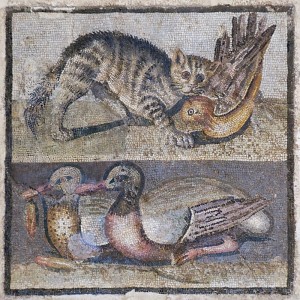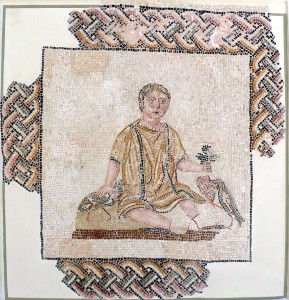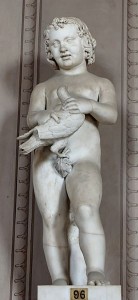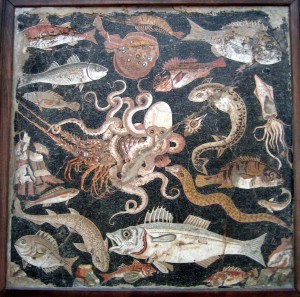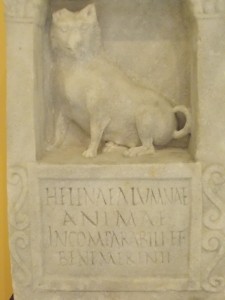What was the most popular pet in roman times
What was the most popular pet in roman times
What was the most popular pet in roman times
Marius:
The Romans did indeed keep all sorts of animals as pets, and many of them would be familiar today. They were great dog-lovers and had several distinct breeds to choose from, whose functions varied from hunting game to keeping the master warm under the covers. (More on Roman dog breeds in a bit; some of them still exist today.)
Besides dogs, Romans were very partial to birds. One need only consider Lesbia’s sparrow to appreciate the possibilities; other avian companions might be anything from a child’s pet chicken to the Ringneck Parakeets imported from India for the nobility. Geese, doves, quail, finches for color, and starlings for mimicry all found their way into Roman homes of even the humbler sort.
Mosaics and bas-reliefs show pet goats hitched to miniature carts; some literature mentions mice being harnessed to wagons the size of matchboxes in the same manner. That the Romans loved these animals rather than merely considering them useful can be deduced from the number of sculptures, especially, showing children and their winged or four-footed playmates. Other figures show animals at play or grooming one another, and the sensitivity of the artwork belies the old stereotype of the Roman as a harsh, unfeeling master.
Monkeys are mentioned sometimes; I doubt they were very long-lived, as even today they are considered very delicate.
One familiar creature that does not turn up often, surprisingly, is the cat. Cats were really only kept extensively in Egypt and lands influenced by Egyptian culture. I suppose one made it to Rome every once in a while, but cats in general never really caught on with the Latins. Romans were dog people and bird people; a cat was more likely to be seen as a nuisance at best, or at worst as a threat. Indeed, the famous mosaic showing a cat pouncing on a dove was more than likely not a tribute to the feline, but a commemoration of the tragic death of a beloved bird!
M Horatius:
There are two pieces of cat evidence regarding the Romans. First: A mosaic from the House of the Faun in Pompeii, showing a cat taking some fowl. It is a spotted gray tabby cat. The cat’s expression is rather well done. Another one is a piece from Britannia. The artifact was a construction piece. There are some cat footprints and a pebble that impacted and stuck to the surface. The cat was walking across the not-yet-set-up surface and someone threw a stone at it to get it off. Typical cat-human interaction: A cat wandering around a construction site in Britannia. Cats were probably widespread. They don’t need that much human aid in spreading.
And what of Libertas? The goddess was said to be especially fond of cats, or was it endearing to them? But anyway a Roman goddess associated with cats would be another indication that they were around more than is generally let on.
Marius:
Roman dog breeds have been mentioned in passing. Most of them fell into easily-recognizeable types. Each breed had its uses, but any dog could also become a pet with house privileges. Here are some of them, and their modern equivalents if any:
For the hunt there were kinds of hounds; sighthounds are well-documented, scent-hounds less so. The greyhound was often represented in sculpture; then as now his sleek lines were appreciated. Oddly enough, one of the first true toy breeds was descended from the greyhound; this «Italian Greyhound» was used as a hot-water bottle when a family member was sick, keeping his master warm by tunnelling under the covers of the bed. To this day their body temperature is higher than that of an ordinary dog. and you can’t keep them off the furniture.
Another famous breed was the Molossus. This hulking beast came from the mastiff family, and was used for guard and protection work. He must have been very effective in that position; mosaics of chained Molossi over the words Cave Canem maintained their deterrent effect even when the house was dogless. In short, if the neighbors even thought you had a Molossus, you were probably safe! Sadly, these good animals were also used in the arena. Their modern descendent is the Neapolitan Mastiff.
The Maltese and similar small dogs already existed in Roman times; then as now, they were kept strictly as women’s companions.
After the conquest of Britain, the Romans began importing the ancestors of the Irish Wolfhound. Some of these were pitted against wolves or Molossi on the sands of the arena; others were allowed to serve their intended function as chasers of wolves and deer. Wolf-hunting on horseback, with the aid of large hounds, was a popular sport on many a frontier.
Not a dog and not quite a pet, the trained hawk or falcon still deserves a mention. Falconry only became established very late in the Roman Empire; yet a stele survives of a Roman cavalryman with a hawk on his wrist, and I am left to wonder what methods were used to train birds of prey four hundred years before the spread of Islam—for the falconry we know today is an Arab innovation.
M Horatius:
Fish were also kept by Romans, who must often have made real pets of them. The first person to build a piscina was a former Consul who upon the death of his fish went into mourning well beyond what was considered appropriate for a child or wife. Some think his own death the following year was because he was so heartbroken over the loss of his fish. Beginning in the second century, piscinae began to appear among the wealthy homes and later became a regular feature in Roman houses.
There is also a tale about a woman who raised snakes; she was often seen about the house with one or two draped about her shoulders and hips, and her neighbors were getting a little nervous. Snakes being associated with health, especially women’s health, there may have been more to this than just petkeeping.
For anecdotal information, Valerius Maximus and Pliny the Elder are good sources. Pliny especially well describes the Romans’ attitudes towards specific animals.
Ancient Links
Pages
Popular Posts
Subscribe To Ancient Links
Thursday, October 14, 2010
Ancient Pets
Ancients kept pets, just like we do, though perhaps the line between working animals and pets wasn’t always as clear as it is today. For the best documented civilizations, such as Egypt, Greece and Rome – we have quite a bit of info about the ancient pets – especially those of the rich and famous.
Pets in Ancient Egypt
Ancient Egypt is the best source of research, though we’re still far from fully understanding how many of the mummified animals found were pets and how many were ceremonial offerings for the gods. It’s probably safe to assume that animals buried alone or with their owner, who were treated with special attention, were kept as pets when they lived.
Based on the paintings found on walls in tombs and temples, cats seem to be the most popular pets in Egypt – which is rather weird, as dogs were domesticated thousands of years before. Cats are often painted as standing next to the owner’s feet or under the chair, a clear indication that they were kept as pets and not just for the obvious purpose of catching rodents.
The Egyptian goddess Bastet had the head of a domestic cat and the body of a woman. She was a benevolent deity, protector of children, mothers and, well, cats, and many cities organized yearly festivals in her honor.
Numerous cat statues and figurines were recovered by archaeologists, as well all sorts of other items depicting cats – amulets, earrings, pendants and so on. It seems at some point the ancient Egyptians introduced the death penalty for anybody who killed a cat.
Dogs were also extremely common in Ancient Egypt, but it seems they were used mostly for hunting and guarding, rather than kept as pets. Anubis, by the way, does not have a dog-head, but a jackal-head. However, part of a cemetery in Abydos was reserved for dogs, and there are also many inscriptions that indicate the names of the dogs, such as The Brave, The Trustworthy or even Blackie.
Trying to trace the origins of our contemporary pets, archaeologists concluded that ancient Egyptians had at least one breed of dogs that was very similar to the modern greyhound.
Paintings also indicate the monkeys were relatively common pets, though it’s difficult to say for how long they could survive in captivity. Pliny the Elder mentions that, during the Ptolemaic dynasty, the baboons kept in Egyptian palaces could play dice and even understand written words.
There’s also evidence that Egyptians kept various birds as pets, and even gazelles.
Pets in Ancient Greece
Ancient Greeks, unlike Egyptians, were not at all fond of cats. Dogs and birds were the most common pets, with an occasional mouse and goat here and there.
In the 5th century BC, Athenian statesman Alcibiades is reported to have purchased a wonderful dog for the price of 7,000 drachmas. By comparison, a regular worker could expect to receive 1 drachma in return for a full day’s work.
Stories of faithful dogs abound in Greek tales. We all know how Odysseus’ dog waited to see his master return home before passing its last breath (which, by the way, means the dog was at least 20 years old when passing away). There’s also a story about Xantipus, Pericles’ father, who once left Athens to go to the island of Salamis, almost 2 km away, but forgot to take his trusted dog with him. The desperate animal jumped into the water and swam the entire distance, following his master’s boat.
Pets in Ancient Rome
Like Greeks, Romans favored birds and dogs as pets, and ignored cats, though it is said that Spartacus chose cats as a symbol of his rebellion, since they were associated with the goddess of freedom, Libertas, for their independent spirit.
Same as Egyptians, Romans had various breeds of dogs, including the one that resembled today’s greyhound. Another popular breed was called Molossus, a huge animal, probably the ancestor of the modern mastiff, used for guarding, and probably for dog fights. Same as today, smaller breeds were mostly kept for company, especially by ladies.
Similar to the Greek literature, there are many stories of faithful dogs. In 28 AD, a dog jumped into the river Tiber to rescue his master, senator Sabinus, who had been pushed in the river by an angry mob. Unfortunately, his master was already dead before the body was thrown away. It’s also said that the soldiers who killed Emperor Galba had to kill his dog too, as it wouldn’t leave his master’s side for anything in the world.
And speaking of faithful animals, ancient Romans had their version of Flipper. During the time of Emperor Augustus, a boy named Hyacinthus, who lived in Baiae, found a wounded dolphin and nursed it back to health. The dolphin would then return everyday, and accompany the boy on his way to school. The boy, however, caught a cold and died. The dolphin waited for him for many more days, until he died too, of grief and sorrow, according to Pliny.
Horses were rarely kept as pets (Caligula’s favorite, Incitatus, was still a racing horse, albeit a luxury one, as I’ve pointed out in the post about Ancient Horses). Emperor Trajan, however, received a pet horse, which was useless for anything except bow down and make pretty pirouettes.
Ancient Romans were especially fond of birds that could be taught to speak. Siblings Britannicus and Nero (who went on to become the famous mad emperor) had several nightingales and starlings who could speak Latin as well as Greek. Pliny claims to have seen these precursors of Google Translate with his own eyes.
Augustus launched the fashion of parakeets and ravens who could speak, and used to pay large amounts for such birds. A poor Roman citizen managed to get his hands on a raven, and tried to teach the bird a few words, hoping the emperor would reward him handsomely. However, the bird was stubborn, and the man kept saying to it “Oh, you’re such a waste of time and money!”. Eventually, the bird managed to learn to utter “Ave, Caesar”, or something similar, and was brought before Augustus, only to hear the emperor say that he had enough of such birds already and was not interested in purchasing more. At that point, the bird showed that education always pays off, and said to the emperor “Oh, you’re such a waste of time and money!”. Augustus had enough sense of humor to purchase the bird on the spot.
There’s also a story about a man who paid an amount that would’ve fetched a vineyard with slaves and wine-making devices in place for just one white nightingale, which he presented as a gift to Caligula’s sister, Agrippina.
Fish make unlikely pets, but the Romans were weird. Of course, fish ponds were generally created and maintained to insure a steady supply of fish for the owner’s meals, and were immensely expensive. A certain Publius Vedius Pollio, however, friend of Emperor Augustus and famous for his wealth and cruelty towards his slaves, managed to keep moray eels as pets. Some of the older and bigger specimens were fitted with jewelry and gems, and they were fed with human slaves who had misbehaved, in their master’s opinion. It has been reported that one of the moray eels in his ponds lived to reach the venerable age of 60. Probably none of his slaves managed that.
What was the most popular pet in Roman times?
Table of Contents
What was the most popular pet in Roman times?
There is a considerable amount of evidence for the keeping of animals as pets in the Roman world and the most commonly attested pets in the Roman world were caged birds, particularly favoured by Roman women. The popularity of caged birds is clearly demonstrated in Latin love poetry.
How did the Seven Hills Help ancient Rome?
Archaeology suggests that Rome began as a confederation of villages on the seven hills of Rome: the Capitoline, Palatine, Aventine, Viminal, Quirinal, Esquiline, and the Caelian. The low-lying ground between them was swampy and malarial. This was to prove an early source of Rome’s wealth. …
Was Rome built on a swamp?
The low land between the two hills was a swamp, rendering the site uninhabitable and disease prone. In 625 BC, the Romans drained the swamp and installed a sewer (Cloaca Maxima). The valley between the hills was now inhabitable and became the center of the Roman government.
Which Roman god was considered the god of the sea?
Why is Italy called the Seven Hills?
Tradition holds that Romulus and Remus founded the original city on the Palatine Hill on April 21, 753 BC, and that the seven hills were first occupied by small settlements that were not grouped. The Capitoline Hill is the location of Rome’s city hall, and the Palatine Hill is part of the main archaeological area.
Why was the location of Rome so ideal?
Rome’s location was ideal because its proximity to the River Tiber ensured that the soil was fertile. This meant that, in most years, at least the city could rely on a regular supply of crops to feed its citizens.
Why was Roman empire so successful?
Rome became the most powerful state in the world by the first century BCE through a combination of military power, political flexibility, economic expansion, and more than a bit of good luck. This expansion changed the Mediterranean world and also changed Rome itself.
How did geography affect the Romans?
Rome’s location on the Italian peninsula, and the Tiber River, provided access to trade routes on the Mediterranean Sea. As a result, trade was an important part of life in ancient Rome. Later, the Roman armies used these same routes to conquer large amounts of territory and expand the empire along the Mediterranean.
How did the Alps Help ancient Rome?
The Alps, located on the northern border of modern-day Italy, seal off the peninsula from the rest of Europe during winter. This natural roadblock protected Rome from outside invasions by forcing attackers to move slowly through narrow passes, giving the Romans time to respond.
How long did Hannibal fight in Italy?
Ancient Roman Pets
Just like people nowadays, the Ancient Romans really loved their pets.
Although not every Roman had a pet of their own, they had a special place in society, and animals owned by humans were treated differently to those found in the wild.
Many Ancient Roman artworks, poems, and pieces of writing confirm this fact.
Birds were one of the most common pets in the time of the Roman Empire. They were kept in cages by their owners. Generally, it was the upper-class Romans (or patricians) who owned birds.
Historians have discovered that although many Romans owned birds, they were regarded as a child’s pet. Because of this, many children’s graves in Ancient Rome were decorated with images of birds.
When the owner of a bird didn’t want to keep the pet in their home, they would pay to have the bird looked after at an “aviary,” a business that took care of other people’s birds for a small price.
They would also sell birds as pets. Birds also played an important role in religious ceremonies and “auguries.”
An augury was a ceremony where a special Roman priest (called an auger) would tell the future using the guts of a sacrificed animal. Because birds were common both in the wild and as pets in Italy, they were often used as the sacrifice.
Aside from birds, though, there was another type of Ancient Roman pet that remains popular to this day: dogs!
There’s plenty of evidence to suggest that pet dogs were kept in Ancient Rome, and that even wild dogs were sometimes domesticated (or trained) to keep people company. If they were particularly vicious, they’d also learn to work as guard dogs.
There isn’t much information available about how the Ancient Romans trained their dogs, but it’s likely that their training followed the same “carrot-and-stick” approach found in other ancient cultures: meaning that when the dog did something right, it was rewarded, and when it did something wrong, it was punished.
As an example of the evidence, historians have found a huge number of ancient dog statues in Italy, dotted all over the countryside in various dig sites.
Dog collars from the time of the Ancient Romans were also discovered in graveyards from the time, having been buried with their owners’ bodies. There’s evidence to suggest that when a pet’s owner died, the pet was sacrificed at their funeral; maybe to keep their masters company in the afterlife.
If a patrician’s dog died, they would get their own gravesite and tombstone, as well as a special plaque to show their name.
The amount of these dog tombstones and collars dug up from the time of the Ancient Romans shows that they were popular pets at this time. The breeds of dog discovered to have been in Ancient Rome include greyhounds, Irish wolfhounds, Maltese dogs and tiny lap dogs.
Fish were another common pet in Ancient Rome, (probably because they were easy to take care of,) and mosaics from the era show that many patricians kept pools of fish in their house for decoration.
Historians have even discovered some documents which show that there were guides to fish-buying and how to take care of your fish sold at the time of the Roman Empire!
What’s somewhat unusual, however, is that cats were not a very popular pet in Ancient Rome.
Historians have accepted that cats were first domesticated (made tame) by the Ancient Egyptians, and that they didn’t spread to the other ancient cultures because of this – but mosaics show that although cats were not common in Ancient Rome, some patricians and plebeians (poor Romans) did own them. However, they were most likely kept as rat-killers rather than beloved pets.
What was the most popular pet in roman times
How is everyone’s summer going? I hope it is going well! So this week’s (and next’s) theme is pets within Ancient Rome. This post will attempt to look at the discuss the popular pets within Ancient Rome. Next week, we will look at the most interesting and bizarre pets from ancient Rome! The following order will be from the least popular to the most popular!
The “Most Unpopular” Popular Pet : The Cat (Latin: Feles or Cattus)
1st-century BC mosaics in Italy, Ancient Roman mosaics in the Palazzo Massimo alle Terme, Birds in ancient Roman mosaics. Courtesy of WikiCommons, Marie-Lan Nguyen, and Jastrow.
Popularity Scale : 4/10
Evidence of the Pet: There are two popular cat mosaics one I provided to the right’ the other is seen under a later pet section. Respectively, the latter is from the House of Faun at Pompeii. The cat as a pet is rarely mentioned (except in the case of a BIG CAT owner- which will be discussed next week). The cat, according to Pliny the Elder, was a practical pet to keep in order to keep mice, ferrets, and moles at bay.
Famous Examples: While not very popular in Ancient Rome, they do have a prevalent presence in Ancient Egypt. Here is an amazing article that examines the feline influence through the ancient world. The cat is often associated with the goddess of freedom, Libertas (for that story- check it out here.)
Roman Mosaic from House of Faun. Courtesy of WikiCommons, Marie-Lan Nguyen, Jastrow.
Fun Facts: I am personally a lover of cats, but apparently they were not popular in Ancient Rome. This may be due to several reasons including the fact that cats are very highly thought of and respected in Ancient Egypt. Perhaps it is this “foreign admiration” that deterred Rome from picking cats as their favorite pet. However, the fact that cats were “unpopular” in Rome does not mean they did not exist. There are a few examples of cats in artwork as I have already listed and provided. Also, this idea that cats are associated with the Roman goddess Libertas or freedom is quite humorous (in my opinion). For any cat owner will tell you that cats don’t listen, care, or really pay attention to their owner unless they have food. They don’t like leashes and are quite “liberal,” “free,” or “independent creatures.”
The Most Beloved Child Pet : The Bird (Latin: Avis)
Mosaic from a Roman funerary monument, depicting a young boy sitting, with a fixed glaze; his right hand holds a partridge, his left a bunch of grapes with a thrush pecking at them. Beginning third century Sousse mausoleum. Courtesy of WikiCommons & Ad Meskens.
Popularity Scale : 7/10
Evidence of the Pet: There are several examples of birds on gravestones of children, on mosaics, and in sculptures. WikiCommons provides an ample source of references here.
Famous Examples: One only needs to recall Catullus’ poem to Lesbia and her “sparrow.” (I would rather not discuss whether the sparrow is an actual bird or an analogy. For the sake of this post, let’s say it is a bird.) The poem may be found here. Birds were even kept as “pets” by priest who would house them as a tool for prophetic or divine interpretation(this was known as augury). Emperor Augustus launched the fashion of parakeets and ravens who could speak, and used to pay large amounts for such birds.
Child playing with a bird. Marble, Roman artwork of the Imperial era,. Courtesy of WikiCommons & Jastrow.
Fun Facts: While birds are now thought to be pets that can be slightly dangerous (due to their disease transmission abilities), they are very popular for Romans. Their presence with children and gravestones is quite interesting and may be a literal portrayal or a symbolic one. For an analysis of the gravestone bird presence; check here.
The Hardest & Easiest Pet : The Fish (Latin: Piscis)
An array of creatures that may have been found in a “piscine.” Sea creatures mosaic from Pompeii; National Archaeological Museum of Naples, Italy. Courtesy of WikiCommons & Massimo Finizio.
Popularity Scale : 7.5/10
Evidence of the Pet: There are several examples of fish on mosaics. Varro even records good habits to maintain while providing and caring for fish; which can be seen here. In addition, evidence of piscina (referring to fish ponds or swimming pools) have been found. More on the structure, habitats, and history of piscine may be found here.
Famous Examples: While it may be unclear which fish were kept by Romans; what is clear is that like today- they were easy pets to maintain. However, the more exotic the fish (saltwater vs. freshwater) the more difficult to maintain. Famously, Augustus’ nephew, Hirrus, was noted to owning and keeping extravagant fish ponds.
Thus Hirrus, who, on one occasion, lent Caesar 6,000 muraenae, at a subsequent period obtained 4,000,000 of sesterces (upwards of 30,0001.) for an ordinary villa, chiefly in consequence of the ponds and the quantity of fish they contained. (Greek & Roman Dictionary; here)
Fun Facts: Quintus Hortensius, a Roman orator, is said to have mourned the loss of his pet fish as if a person- or family member- had died. Historians are quite sure that while fishes were kept as pets; they were never used for the famous condiment known as Garum. This obviously makes sense since even farmers who raise pigs, cows, etc. have a difficult time (if they are able to at all) to eat their livestock if they treat them more like pets.
The Most Popular Pet : The Dog (Latin: Canis)
CAVE CANEM “Beware of Dog!” Mosaic. Courtesy of WikiCommons & Radomil. For more on this piece: here.
Popularity Scale : 9/10
Evidence of the Pet: The evidence for the popularity in dogs is the same as the other pets listed above: artwork, literature, etc. However, the reason I would argue that this pet was the most popular is the undying terminology of “Man’s Best Friend.” One fine scholar examines the dogs role (including the lap-dog) in the Classical Journal: here.
Famous Examples: The most famous examples have been provided in the images in this post. The “Beware of Dog” mosaic and the gravestone of Helena.
“To Helena, foster daughter, the incomparable and worthy soul.” 150-200AD
Courtesy of Brittany Brittaniae.
Fun Facts: The name “Fido” has often been coined as a popular name for a dog. The name actually comes from the Latin word Fidus meaning faithful, loyal, trustworthy. This common name shows a nice parellal that cats (libertas) and dogs (fidus) have. The blog has also written a whole article dedicated to this gravestone of Helena, which can be read here. Also, the following page (here) has a sundry of artworks, coins, and descriptions of dogs as pets. This of course outweighs and outshines previously mentioned pets; thus, this confirms my statement that dogs were the “most popular pets.”
Build vocabulary, practice pronunciation, and more with Transparent Language Online. Available anytime, anywhere, on any device.







